Posted: May 6th, 2014 | Author: Nathan | Filed under: gear, music, sound design, synthesis
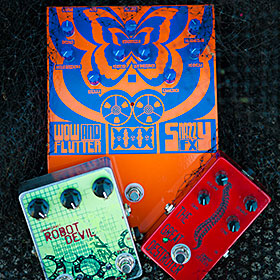
Sometimes sound design requires thinking inside of multiple boxes.
I’ve developed a small collection of handmade and boutique electronic effects and instruments over the years, like the Grendel Drone Commander, Lite2 Sound PX, and many more (perhaps the subject of another post). Longtime readers may recall that I just love supporting independent makers and small cottage industries: That’s where all the weird, truly innovative stuff happens, and I (like many of you, dear readers) am more interested in cool sound design possibilities than straight-up distorted guitarrrrrrrr sounds.
Beyond this, I’ve also been expanding my collection of effects pedals. My latest three are definitely the weirdest: The Great Destroyer and Robot Devil from Dwarfcraft Devices, and the Wow & Flutter from Snazzy FX.
Read the rest of this entry »
Tags: effect pedal, sci-fi, sound design, sound effects | No Comments »
Posted: April 2nd, 2014 | Author: Nathan | Filed under: field recording, gear, sound design
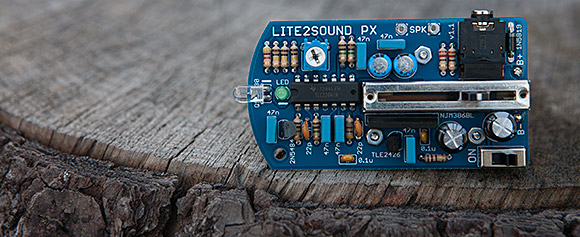
Rare Waves’ Lite2Sound PX, by Eric Archer: A photonic microphone!
I’ve previously written about the heavily-built, wickedly cool Grendel Drone Commander synth from Eric Archer. I check his site, Rare Waves, from time to time for new handmade electronic toys, and I was really intrigued by his newer Lite2Sound PX unit. This small device, in Eric’s words, “extracts audio from ambient light.” It’s a photodiode amplifier. Or a photosensitive microphone. Point it at light, it makes sound. It runs off a 9-volt battery, has a volume control, and a headphone jack. Simple, exciting, and a whole new world of sonic insanity. You can buy them as kits or, as I did, fully assembled.
Sounds pretty straightforward. If you just point it at bright, broad light sources, it’s kind of disappointing. It’s when you start listening to artificial lights in otherwise dim environments that some serious magic starts to happen. My experiments were conducted in and around high tech computer equipment, running an 1/8″ mini jack from the headphone output into my Sony PCM -D50 recorder.
Lights inside of PCs, modulated by fans…and further modulated by speaker grills as I passed the Lite2Sound from side to side. Ethernet network activity lights. Server disk access indicator lights. A close up of the power button of an XBox 360 while booting up. Pulsing lights of devices in standby mode. Halogen lamps behind spinning desk fans.
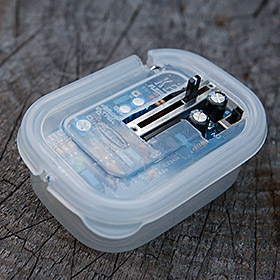
Lightly armored for future fieldwork!
The resulting sounds were astounding in their range: Static, glitches, distorted synth pads, pure sinewave tones, sawtooth-like tones, and much more. You can’t control it, really. It’s a tool of discovery, and its very nature encourages constant experimentation. It was so small and so perfectly complemented a handheld field recorder, I just wanted to take it everywhere and point it at everything! It imparted the same joy as when you start recording with contact microphones, or hydrophones: A new way to listen to the world around you. The more I used the Lite2Sound, I put it in a small plastic container (hacked with an XActo knife for access to controls and the headphone jack) in order to keep the components better protected.
Lite2Sound is a pretty narrowly-focused device and how useful it is to you depends on your taste for the unpredictable. Me, I adore this thing. Hell, I bought two (for future stereo photo-phonic insanity). It encourages constant experimentation, weighs nothing, and I can see using its output in both sound design and musical contexts. Eric Archer nails it again with an odd concept and a rock-solid, focused execution that results in a toy that just begs to be played with.
[soundcloud url=”https://api.soundcloud.com/tracks/139812053″ params=”color=ff5500&auto_play=false&hide_related=false&show_artwork=false” width=”100%” height=”166″ iframe=”true” /]
Tags: audio equipment, digital audio, field recording, sound design, sound effects | 3 Comments »
Posted: December 1st, 2012 | Author: Nathan | Filed under: field recording, gear

The Nexto DI NVS1501 is a burly, professional, and pricey way to back up flash media in the field without a host computer.
[Editorial note: This is an expression of my opinions about this piece of equipment. It was purchased and not provided by the manufacturer. I have no relationship with any company listed below.]
There aren’t many options available for in-the-field, no-computer backups for those of us recording to flash media, like Compact Flash cards, Memory Sticks, and SDHC cards. The most readily-available solutions are usually oriented towards photographers, focusing more on being digital photo albums than professional devices that makes our data more secure, and sometimes only accept JPGs, not arbitrary file types (like, oh, say, .wav files). Some devices, like the Sound Devices 700 series field recorders, will let you write to two pieces of media at once, but what about trips so long that you might need to reclaim CF card space? Or the other devices that we bring with us, like cameras, which can’t do that? Or the majority of trips that I take where carrying a laptop is more hassle or risk than it’s worth?
Enter Nexto DI, a little-known Korean manufacturer of field backup devices oriented towards filmmakers and cinematography digital imaging (DI) technicians. I decided to try the Nexto DI NVS1501 in its 500GB size as a field backup device for four specific pieces of media-capture gear, which could all be in my kit on some trips: the Sound Devices 702 field recorder, the Sony PCM-D50 handheld field recorder, the Canon 7D DSLR, and the GoPro HD Hero 2 POV camera.
Read the rest of this entry »
Tags: audio equipment, backup, field recording, review, travel | 3 Comments »
Posted: October 19th, 2011 | Author: Nathan | Filed under: gear, music, sound design
 There are lots of under-the-radar software toys out there for mangling audio, but one that I have yet to hear anyone really discuss much is Spongefork, created by Ryan Francesconi over a decade ago. It’s been around for a long time, and is intended as a live improvisation instrument. Its incredibly sparse interface belies a lot of sonic mangling possibilities, with multiple sample banks and a live-control XY controller. For $65, it’s a fun toy. (Even the demo fully works, just without the ability to save work.) Heck, I’ve used it so long that I upgraded when I made the move from Mac OS 9 to OS X!
There are lots of under-the-radar software toys out there for mangling audio, but one that I have yet to hear anyone really discuss much is Spongefork, created by Ryan Francesconi over a decade ago. It’s been around for a long time, and is intended as a live improvisation instrument. Its incredibly sparse interface belies a lot of sonic mangling possibilities, with multiple sample banks and a live-control XY controller. For $65, it’s a fun toy. (Even the demo fully works, just without the ability to save work.) Heck, I’ve used it so long that I upgraded when I made the move from Mac OS 9 to OS X!
Here’s a set of live tweaks to some sheet metal hits (recorded when we had a custom heat shield fabricated for our wood stove). In my library, when I see “forked” in a filename, I know it’s gonna get weird…
[soundcloud url=”http://api.soundcloud.com/tracks/25411488″ params=”show_comments=true&auto_play=false&color=ee0000″ width=”100%” height=”81″ ]
| 1 Comment »
Posted: July 21st, 2011 | Author: Nathan | Filed under: gear

The home studio, circa summer 2011.
Following on my previous post, here’s how I break down data storage, redundancy, and backup in my own home studio. These strategies won’t work for everyone, but having tried lots of different configurations, this setup balances redundancy, backup, flexibility, speed, and most of all, cost. And, of course, this breakdown is only useful in the small home studio. Larger studios have totally different needs!
Read the rest of this entry »
| 4 Comments »
Posted: July 14th, 2011 | Author: Nathan | Filed under: gear
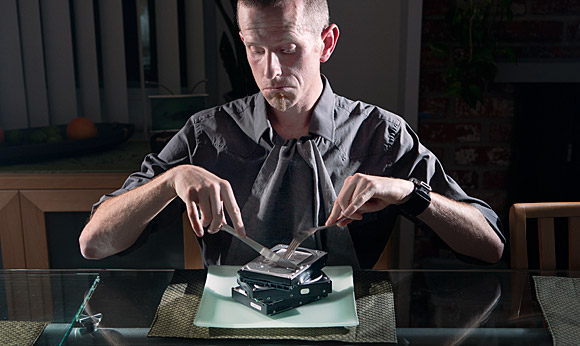
Bits and bytes are mighty tasty. How does one store them for maximum freshness?
Portrait of the Artist as an IT Professional
Artists, designers, composers, mixers, and audio folks of all stripes must be conversant with the tools of their trade, and in this digital world, that means playing some role in managing hardware and software. This is where your hard-won creative output of blood, bits, and tears will be stored…and possibly lost.
This article is meant to help frame the challenge of selecting hard drives for one’s own home studio. I’m no IT professional, but I’ve been dealing with digital multimedia production for nearly 20 years, so I’ve at least got some perspective as a creative professional. I’ve seen my share of hard drives literally catch fire, glitch out, play the national anthem, and just simply stop working, sometimes one a day for three days in a row. I’ve had to manage IT issues from single machines to small clusters to an entire small studio. What follows, then, is what home-studio creatives of all stripes should consider when thinking about storing their creative output on hard drives.
Read the rest of this entry »
Tags: audio equipment, backup, data, hard drive, hardware, home studio, SSD, storage | 3 Comments »
Posted: July 6th, 2011 | Author: Nathan | Filed under: gear, music, sound design, synthesis
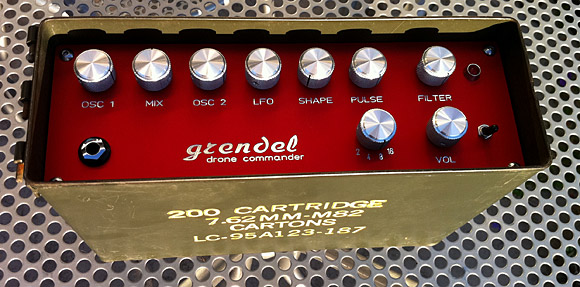
Of COURSE I had to get it in red.
Hand-built one at a time by Eric Archer, the Grendel Drone Commander is a two-oscillator synth built inside of a metal surplus ammo box. Its apparent simplicity belies its sonic complexity. I’m still feeling my way around the thing, but I wanted to post an example of what it makes possible. (Next step: Play with CV control!)
This heavy, drone-y, smeary track was created using only the Grendel Drone Commander, recorded live thee times, each on a different track, in Logic Pro (with a few plug-ins as well).
[soundcloud url=”http://api.soundcloud.com/tracks/18374428″ params=”show_comments=true&auto_play=false&color=ee0000″ width=”100%” height=”81″ ]
| 7 Comments »
Posted: July 9th, 2010 | Author: Nathan | Filed under: field recording, gear, nature recording

Lookit that man out there. He's quite a dish.
One of the best reasons to spend a weekend with other sound recordists is a chance to try out new gear. A classic nature recording technique is the use of a microphone set in a parabolic dish.
The general public knows of parabolics mostly from seeing people use them on the sidelines of sporting events. In nature recording, they’re for capturing species-specific sounds rather than ambiences. This is because the microphones in parabolic dishes are mono, and have sound pushed into them by the dish itself. This creates a very narrow “beam” of listening. Perceptually, parabolics seem like they “zoom in” on sounds, but this is simply due to such microphones just attenuating all the sounds outside that narrow cone.
Parabolics are also interesting because the frequency response is directly tied to the size of the dish. For most song birds, this is fine. Besides, making and transporting a 17-meter-wide dish just to get a 20Hz-20kHz frequency response just seems silly. At that point, you’re practically into SETI territory! :-)
I got the chance to use one at the Nature Sounds Society Field Workshop. The unit you see in the photo above was the one used by the founder of the NSS, Paul Matzner, so I was holding a bit of history: Hand-made of fiberglass and aluminum, the NSS archives have lots of photos with Matzner holding this thing. Had I looked at the archives before heading into the field, I’d have gotten a way better handling technique. Holding it by its edges introduced horrendous amounts of handling noise.
Today’s sound is from this unit, recorded at 5:01am at Yuba Pass, off California Route 49. As far as I can tell, this is a chestnut-backed chickadee. You can tell, even in this recording, he’s got a lot of pals around (woodpeckers and sparrows at least).
[soundcloud url=”http://soundcloud.com/noisejockey/chestnut-backed-chickadee-yuba-pass-ca” params=”show_comments=true&auto_play=false&color=dd0000″ width=”100%” height=”81″ ]
[DPA 4006 omni microphone in custom 1m parabolic dish into Sound Devices 702 recorder]
Tags: audio equipment, birds, birdsong, digital audio, field recording, microphone, nature, nature recording, parabolic dish, Sierra Nevada, sound effects | 4 Comments »
Posted: July 3rd, 2010 | Author: Nathan | Filed under: field recording, gear, nature recording
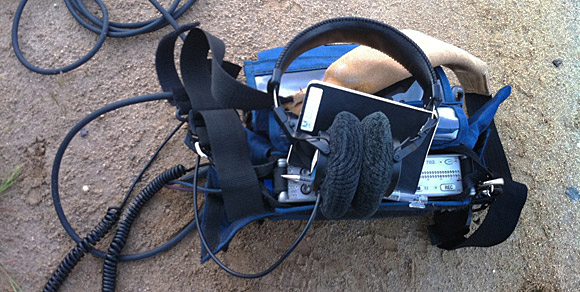
Neither dirt, nor fog, nor clouds of mosquitos keeps a field recordist from his crack-of-dawn tasks!
I’m finally unpacked and rested from the inspiring (and exhausting) 26th Annual Nature Sounds Society Field Workshop in California’s Sierra Nevada. Since my last post was a compilation of high-level personal experiences, I thought that I’d report back about what worked, or didn’t work, in the field on the technology side of things…as well as share a recording from our first early-morning field session.
- Outdoor Gear. My REI trail stool was instrumental in keeping my body still (I can be a fidgety so-and-so), the importance of which can’t be understated when your preamp gain is at 80% of maximum and you can hear birds’ wing flaps 20 meters away. [Hint: For nature recording, more layers of softer materials – like fleece, soft-handed polyester, and wool - are the best for staying warm and silent. Consider gaffer-taping your metal zippers, too!]
- Microphones. My primary MKH 50/30 rig performed brilliantly, with a strong signal-to-noise ratio even in the quietest moments. I also got a chance to try out a rather large parabolic microphone…more on that in a later post. [Hint: If you want a mic for nature recording, you need to be looking in the <-16dBA self-noise range, the lower the better.]
- Recorders. The ol’ 702 worked its usual wonders. I monitored as mid-side in the field, only converting to left/right once I returned. A +8dB side signal using Tom Erbe’s +Matrix plug-in made for a wide, enveloping sense of space without losing center imaging. Â [Hint: Batteries drain faster when cold. Store spares inside your jacket, or in your sleeping bag with you overnight!]
The gear list across everyone was pretty insane: many Olympus LS10 recorders, several Sound Devices 744T’s, a Sony PCM-D50, and mics from DPA, Neumann, Røde, Sennheiser, and Telinga. Recording techniques varied from mono to mid-side stereo, XY stereo, ORTF, Jecklin discs, and even two binaural dummy-head rigs (see this site for a good explanation of all this alphabet soup). An outdoor mic directionality seminar helped to illustrate what each is good for, which was a rare opportunity and extremely educational.
Yeah, yeah, whatever. But what did it sound like?
Today’s sound was recorded around 5:45am on a day with a slight breeze and scads of ground fog. The location was Sierra Valley, north of state route 49 in the Sierra Nevada. This recording includes at least swallows (cave or barn, I’m unsure), American bitterns, red-winged blackbirds, white-faced ibises, yellow-faced blackbirds, and a bullfrog, and certainly more that I can’t identify.
Get those headphones on and close your eyes…
[soundcloud url=”http://soundcloud.com/noisejockey/amb-bird-dawnchorus-sierravalley-01″ params=”show_comments=true&auto_play=false&color=dd0000″ width=”100%” height=”81″ ]
[Sennheiser MKH 50 and MKH 30 recorded as mid-side pair into Sound Devices 702 recorder]
Tags: audio equipment, birds, birdsong, camping, digital audio, field recording, microphone, nature, nature recording, Sierra Nevada, sound design, sound effects | 5 Comments »
Posted: June 24th, 2010 | Author: Nathan | Filed under: field recording, gear, nature recording, news
This weekend, I’m attending the 26th Annual Nature Sounds Society Field Workshop. Held in the Sierra Nevada mountain range at an SFSU field research station, this year’s instructors will include Gordon “One Square Inch of Silence” Hempton and others, with naturalist and illustrator John Muir Laws as a guest lecturer.
I thought it might be interesting to share what I’m bringing with me to this interesting outing. (Well, OK, fine, I really needed to make a packing list and I just suckered you into reading it.) Later this summer, I’ll not only share some recordings and photos from the field workshop, but will recap the gear used and how it all performed.
So, what am I bringing?
Read the rest of this entry »
| 6 Comments »




 There are lots of under-the-radar software toys out there for mangling audio, but one that I have yet to hear anyone really discuss much is
There are lots of under-the-radar software toys out there for mangling audio, but one that I have yet to hear anyone really discuss much is 



